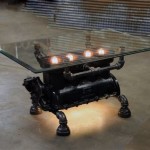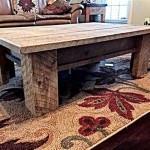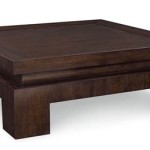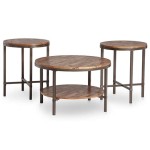Optimal Side Table Height Relative to the Bed
The question of whether a side table should be lower than the bed is a common consideration when designing a bedroom space. The answer, however, is not a simple yes or no. A variety of factors influence the ideal height of a side table, with the primary goal being to maximize functionality and comfort for the user. Aspects such as bed height, individual preferences, and the intended use of the side table all play a significant role in determining the most appropriate dimensions.
A side table serves as a convenient surface for various items, including lamps, books, electronic devices, and beverages. Its positioning is crucial for ease of access and to avoid unnecessary strain when reaching for these items. An improperly positioned side table, whether too high or too low, can disrupt the user's comfort and overall bedroom aesthetic. Therefore, understanding the principles of ergonomic design and individual needs is paramount in making an informed decision regarding side table height.
Ergonomic Considerations: Reaching and Accessibility
Ergonomics focuses on designing and arranging workspaces to optimize human well-being and overall system performance. When considering the height of a side table, ergonomics dictates that the primary concern should be the ease with which a person can reach and interact with the items placed on the table. This involves minimizing unnecessary stretching, bending, or straining, which can lead to discomfort and potential long-term health issues.
Ideally, the surface of the side table should be at the same height as, or slightly lower than, the top of the mattress. This allows a person lying in bed to easily reach for items without needing to sit up or contort their body. Reaching downwards is generally more comfortable and natural than reaching upwards, especially when in a reclined position. A side table that is too high can force the user to reach awkwardly upwards, putting strain on their shoulder and neck muscles. This can be particularly problematic for individuals who frequently use their side table for reading, using electronic devices, or taking medication during the night.
The depth of the side table is also a factor to consider in relation to ergonomic reach. A table that is too deep might require the user to reach further, even if the height is appropriate. Ensuring that the items are within easy reach without requiring excessive stretching is key to promoting comfortable and healthy use. The positioning of the side table relative to the bed is also crucial. It should be close enough to allow easy access but not so close that it obstructs movement or feels cramped.
Bed Height and Mattress Depth: The Foundation for Decision-Making
The height of the bed itself is the most critical factor in determining the ideal side table height. Beds vary significantly in height depending on the frame design, the thickness of the mattress, and the presence of box springs. A low-profile platform bed will naturally require a lower side table than a high-standing bed with a thick mattress and box spring.
To accurately determine the optimal side table height, the first step is to measure the height of the bed from the floor to the top of the mattress. This measurement provides a baseline for selecting a side table that aligns with the bed's profile. Once the bed height is established, it is recommended to select a side table that is either the same height or no more than a few inches lower. This ensures a seamless transition between the bed and the table, allowing for easy access to items without requiring excessive reaching or bending.
Special consideration should be given to beds with adjustable features, such as adjustable bases. These beds allow users to raise or lower the head and foot of the bed, which can alter the effective height of the sleeping surface. In such cases, it is important to consider the typical sleeping position and the corresponding bed height when choosing a side table. Selecting a side table with adjustable height options can be a practical solution for beds with adjustable bases, as it allows the user to fine-tune the table height to suit their preferred sleeping position.
Functionality and Intended Use: Tailoring the Height to Specific Needs
The intended use of the side table significantly influences the ideal height. A side table primarily used for holding a lamp and a book will have different height requirements than one used for holding a laptop, a charging station, or medical equipment. Consider the activities that will be performed on or near the side table and choose a height that facilitates these activities.
For instance, if the side table is intended to serve as a temporary workspace for a laptop, a slightly higher table might be preferable. This allows the user to sit comfortably in bed and type without hunching over. However, it is important to ensure that the table is not so high that it obstructs the user's view of the television or creates an awkward angle for the wrists and arms.
If the side table is primarily for holding a lamp, the height should be sufficient to provide adequate lighting for reading or other activities. The base of the lamp should be positioned at a height that allows the light to illuminate the desired area without creating glare. A lower side table might be suitable for a small bedside lamp, while a higher table might be necessary for a larger lamp with a taller base.
Furthermore, the storage capacity of the side table can also influence its height. A side table with drawers or shelves might need to be slightly taller to accommodate the storage compartments. However, it is important to ensure that the height of the table does not compromise the user's ability to reach the items placed on the top surface. Balancing storage needs with ergonomic considerations is crucial in selecting the appropriate side table height.
Ultimately, determining the optimal side table height involves a comprehensive assessment of individual needs and preferences, bed height, and intended use. While a slightly lower side table is often recommended for ergonomic reasons, the ideal height may vary depending on the specific circumstances. By carefully considering these factors, it is possible to choose a side table that enhances comfort, functionality, and overall bedroom design.
In addition to height, the style and design of the side table should complement the overall bedroom decor. The material, color, and shape of the table should harmonize with the existing furniture and create a cohesive aesthetic. Selecting a side table that not only meets functional requirements but also enhances the visual appeal of the room is an important aspect of interior design. Consider the overall style of the bedroom – whether it is modern, traditional, minimalist, or eclectic – and choose a side table that aligns with the desired aesthetic.
Finally, it is worth considering adjustable side tables. These tables offer a range of height settings, allowing you to customize the height to suit your specific needs. Adjustable side tables are particularly useful for individuals who have varying needs or who may use the table for different purposes at different times. They can also be a good option for guest rooms, where the height of the bed may vary depending on the guests.

Our Ultimate Guide To Bedside Table Sizes

Our Ultimate Guide To Bedside Table Sizes

Our Ultimate Guide To Bedside Table Sizes

Should Nightstands Be Higher The Same Height Or Lower Than Beds

How To Choose The Ideal Nightstand Bedside Table Linenme

How To Match A Bed And Bedside Tables Top 10 Design Tricks

Our Ultimate Guide To Bedside Table Sizes

Our 3 Best Tips When Choosing A Bedside Table Lamp Let S Revamp Property Styling

Our Ultimate Guide To Bedside Table Sizes

How Tall Should A Nightstand Be It Taller Than The Bed
Related Posts








